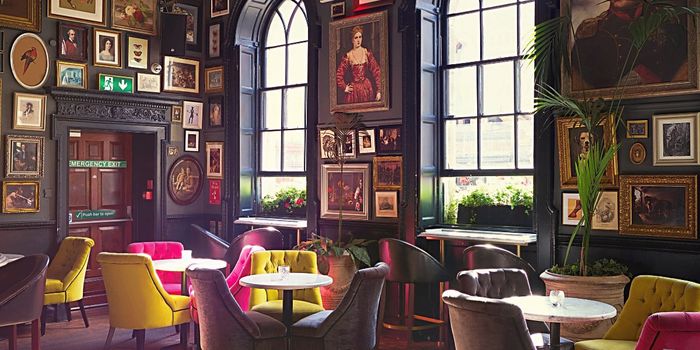
Psychology of Restaurant Designs
A good restaurant design should be visually appealing. It also influences customer behaviors and overall dining experience. The psychology of restaurant design is an emerging field of study that focuses on understanding the impact of various design elements on customers' perceptions, emotions, and behaviors.
It explores how factors such as lighting, color, restaurant seating layout, music, and decor can influence customers' decision-making, their comfort level, and the likelihood of them returning to the restaurant. Understanding these psychological principles can help restaurant owners and designers create spaces that look good and enhance the customers' overall dining experience.
Colour Palette of Your Furniture
The colors of restaurant furniture have an impact on the subconscious of customers. Different colors can evoke different emotions and create distinct moods. Bold and vibrant colors like red or yellow and shades of these colors are known to stimulate the appetite and increase heart rate, making it a popular choice for restaurants.
However, too much red or yellow can create a sense of urgency and make customers feel rushed. Strategic use is recommended with red. Calming and soft colors like blue and pastel-toned colors can create a relaxed and tranquil environment, which is ideal for fine dining restaurants. Understanding the subconscious meanings of colors will help with the psychology and vibe of the restaurant.
Lighting of the Space
A restaurant's lighting influences the mood, behavior, and overall dining experience of customers. Bright, harsh lighting can create an energetic and fast-paced atmosphere and might not be a favorite for every type of customer, while dimmer, softer lighting can create a more relaxed and intimate environment.
Warm lighting can create a cozy and inviting atmosphere, while cool lighting can create a more modern and sophisticated vibe. The lighting can also affect customers' appetites. Bright lighting can stimulate the appetite, while dimmer lighting can suppress it.
Warm lighting can make food appear more appealing and appetizing, while cool lighting can make it appear less appetizing. By considering these details, deciding on the lighting will have a positive or negative impact on the psychology of the customers.
Smell of Your Restaurant
Certain smells make the customers feel hungry or calm, such as lavender or sage, while heavier smells will do the opposite. Choosing to have calming and light fragrances will make the customers feel better while choosing fragrances that are heavier and not too pleasant will cause the customers to have headaches and ruin the dining experience.
The fragrance itself can be a strong enough stimulus to make the customers feel either happy to be in your restaurant or hate every second of it. By picking pleasant fragrances that can also soothe and suit the overall vibe and atmosphere of the restaurant, you can increase the positive exterior stimulus, which is a way how the psychology of restaurant designs affects customers.
Acoustics of the Space
The acoustics of a restaurant is a psychological fact that happens through noise levels that are too high or low, making the space either stressful or too silent, as well as affecting the communication between customers and, as a result, affecting their mood. Good acoustics allow for clear communication between customers and staff, which is important for customer satisfaction and staff efficiency.
Good acoustics create a perception of quality and professionalism, enhancing the overall experience and increasing customer satisfaction. Good restaurant acoustics will also prevent customers from getting headaches and feeling on edge due to the extreme external stimulus. Proper acoustics management can help create a comfortable, relaxing, and enjoyable environment, leading to increased customer satisfaction and loyalty.
Music
Music is the essence of strong feelings. It affects the customers’ mood, eating pace, perception of time spent in the restaurant, image of the establishment, and emotional state. Soft, slow music can create a relaxed and peaceful atmosphere, while upbeat music can create a lively atmosphere.
Studies have shown that fast music can encourage customers to eat more quickly, while slow music can encourage them to eat more slowly and savor their food. The type of music played can evoke specific emotions in customers. It can also help to reinforce the brand image of the restaurant. By choosing the right music, restaurant owners can create a more enjoyable, relaxing, and satisfying dining experience for their customers.
Furniture Layout
Comfortable and well-spaced furniture can create a relaxing and comfortable atmosphere for customers. Uncomfortable or poorly arranged furniture can make customers feel uneasy or restless, leading to a less enjoyable dining experience. The layout of furniture can affect the level of social interaction among customers.
For example, communal restaurant tables can encourage customers to interact with each other, while small tables can create a more intimate atmosphere for couples or small groups. The layout of furniture can also affect customers' perception of space.
A crowded or cluttered layout can make customers feel cramped and uncomfortable, while a spacious layout can make customers feel relaxed and at ease. By making sure the restaurant layout is airy and allows movement of customers and employees as well as looking appealing, the customers will feel rather comfortable and make them feel at safe since the space is not chaotic or uncomfortable.
Furniture Material
The material of furniture in a restaurant is the customer's perception of quality. As the more high-quality the furniture is, the more customers will also feel as important and valued. The material also affects comfort, aesthetics, hygiene, and sound absorption. Different restaurant chair models or restaurant sofas can have different levels of comfort and aesthetics, which will also impact the perception of the space's quality.
Choosing high-quality, comfortable, and aesthetically pleasing materials guarantees a more enjoyable, relaxing, and satisfying dining experience for their customers. This will also make the customers feel they are also of high quality, and this will reinforce the idea of self-importance and respect, which can be considered as a benefit of the exterior on the psychology on the customers.
You can reach our previous article from https://www.buserproject.com/en/effects-of-school-furniture-on-students-bd-2034
